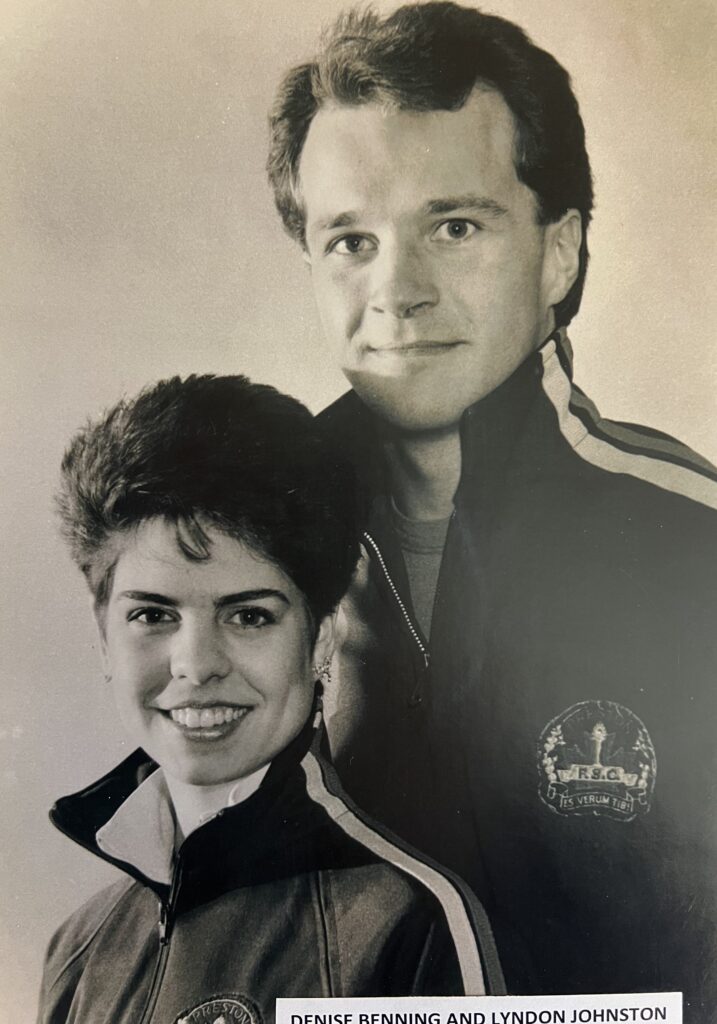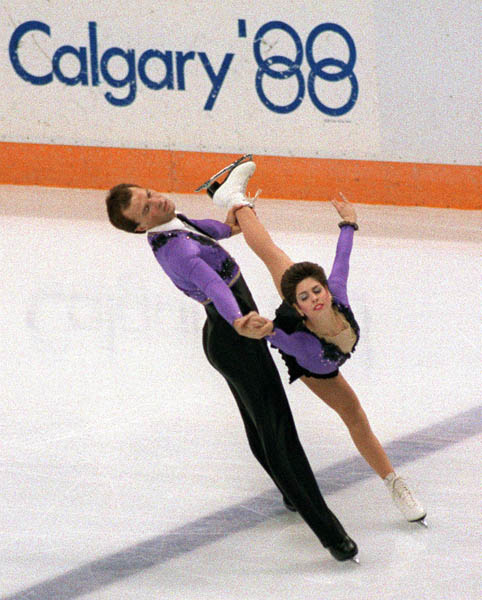
The 1970s and 1980s were the glory years for the Preston Figure Skating Club and few pairs teams rose as high on the international stage as Denise Benning and Lyndon Johnston.
Indeed, the pair achieved results at the World Figure Skating Championships that few Canadian pairs teams have bettered.
Their pairs partnership came about at the Preston club following Johnston’s highly successful stint with partner Melinda Kunhegyi which ended with Kunhegyi’s retirement in 1985.
Benning, born September 1, 1967, in Windsor, and Johnston, born December 4, 1961, in Hamiota, Manitoba, won bronze at both the 1985 NHK Trophy, and the invitation-only 1985 Skate Canada International, which was a prelude to the 1998 Calgary Olympics.
Several former Cambridge skaters have skated well at Skate Canada competitions, including both Toller Cranston and Ron Shaver, who both began at the Galt Figure Skating Club. The list of Skate Canada pairs victors from the Preston Figure Skating Club is a long one and includes several Cambridge Sports Hall of Fame inductees such as Coull and Rowsom, Hough and Ladret, and Brasseur and Eisler.
The NHK Trophy, an international, senior-level figure skating competition held as part of the ISU Grand Prix of Figure Skating series, is hosted by the Japanese Skating Federation.
At the 1986 Skate America competition they won silver, and were three-time Canadian national medalists (silver in 1986 and 1987, bronze in 1988).
The pair finished fifth at three consecutive World Championships and sixth at the 1988 Winter Olympics in Calgary.
The pair were also three-time National Four Skating Champions (1986-1988). See the CSHF Inductee plaque for Kunhegyi and Johnston for a description of the Four Skate event.
Benning got her start in the sport with the South Windsor Skating Club.
With Johnston, Benning finished fifth at three consecutive World championships (1986, 1987, 1988).

Competing at the Calgary Olympics, on home soil, was a highlight, though not without its challenges for Benning.
“We were expected to win Canadians that year,” she explained, “but I did not skate well. My nerves got the best of me. And so we were third but we were really lucky because they were sending three pairs to the Olympics that year.”
Benning was always a good short skater and loved performing. The competition aspect was always a challenge for her.
On the eve of the long program, Benning was not sure she could compete. “I went to my sports psychologist and told him I just wanted to crawl into a hole.”
The sports psychologist knew what to do. He sat her down with the world single champion Brian Orser.
“Brian, tell her a story.”
Orser related a similar story that had happened to him at the 1984 Sarajevo Olympics.
“In Sarajevo, he had a moment like that when he got overwhelmed.” He was expected to win and the pressure was mounting.Becky Gough and Mark Rowsom


“What he did the night before his long program was he went for a walk and looked at the Olympic flame. He got strength by looking at it and realizing he had trained for this moment and deserved to be there. It was all about the experience and it didn’t matter what was going to happen. He needed to do it for himself, and also for all the people who were supporting him and guiding him along the way.”
Banning took it to heart. “That’s what I did the next day. I took some time and walked down to McMann Stadium and I stood and looked at the Olympic flame and I gathered a lot of strength from there.”
That evening they competed in the long program. “I used to like to stand at the entranceway before getting on the ice and doing warmups. I really gathered a lot of strength from that. I remember standing at centre ice (just before the program) and I literally looked at a man sitting in the audience and kind of winked and acknowledged that I was here and let’s have some fun.”
Johnson and Benning skated a routine that, although not perfect, was something they could be proud of. Ranked fifth in the world, they finished sixth. And they were the top Canadian team.
After the performance “they had this really cool thing called the Intranet where they had these little computer consoles all over the Olympics and you could type in an athlete’s name and send them a message. In 1980, it was magical.”
It was 1988 and the internet was unknown to most people. That first message from Benning to Orser was a precursor of what was to come. Only seven years later, by 1995, the internet and the World Wide Web were established phenomena.
“The first thing I did was I got off the ice and I went to the little computer console and I sent a message to Brian Orser.”
Her first computer-to-computer message on that early Olympic network was simple.
“Thank you,” she typed. “I told him I made it and I had taken his advice.”
He had helped her clear a big hurdle at an important moment in time. She never forgot it.
“To this day, when I really need to remember that I can do things that maybe I’m afraid of, I think of that moment at centre ice (at Calgary).”
She might have thought briefly about how her coaching had been first-rate, including that of Leitch and Sheldon Galbraith. About the years of training and sacrifice, the years of fun with her teammates. At the Preston club, they had something special, almost akin to a family.
Benning graduated from the University of Windsor with a Bachelor of Human Kinetics degree, where she majored in Sports Administration. She worked at International Management Group (IMG) in Toronto, was the Coordinator of Athlete Programs at Olympic Spirit Toronto, and was an event director at Wendy Kane and Associates.
In 2003, Benning was inducted to the Windsor Essex/County Sports Hall of Fame.
As for Johnston, after his successful years with Benning, he had a third act, and arguably his most successful, when he paired with Quebec skater Cindy Landry. They began skating together in late 1988 and won silver at the 1989 World Championships, and followed that up with a gold medal at the 1990 Canadian national championships.
They placed ninth at the 1990 Worlds and then turned professional.
Despite the success that Johnston had with Kunhegyi and would later have with Landry, the Benning/Johnson partnership, which won several international medals, including silver at the 1986 Skate America competition and gold at the St. Ivel International in 1987, was one of the best figure skating pairs teams that Canada ever produced.
Make a donation today, and support the Cambridge Sports Hall of Fame.
Cambridge Centre Mall
425 Hespeler RoadUnit #6, PO Box 444 Cambridge, Ontario N1R 8J6
General inquiries: info@cambridgeshf.com Archives and Nominations: cshf1@live.com
© 2025 All Rights Reserved.